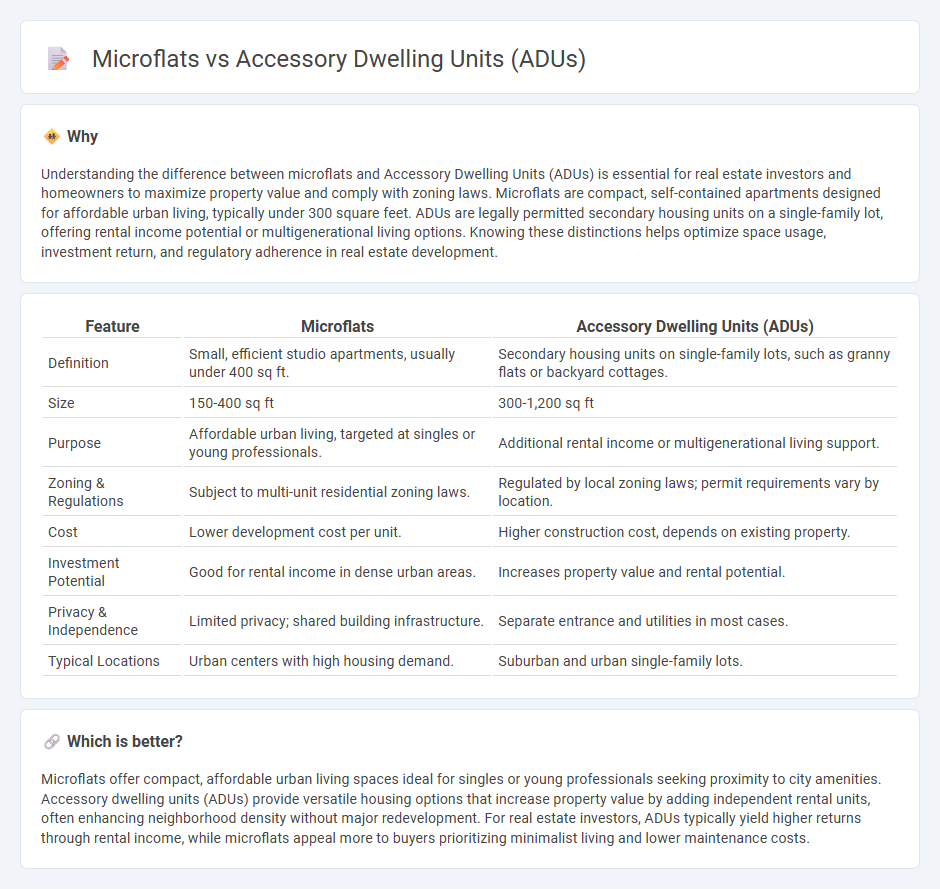
Microflats and Accessory Dwelling Units (ADUs) offer distinct real estate solutions that cater to urban density and affordability challenges. Microflats maximize limited living spaces through minimalist design, while ADUs provide flexible, secondary housing options on existing residential properties. Explore the unique benefits and regulations surrounding microflats and ADUs to determine which suits your real estate needs best.
Why it is important
Understanding the difference between microflats and Accessory Dwelling Units (ADUs) is essential for real estate investors and homeowners to maximize property value and comply with zoning laws. Microflats are compact, self-contained apartments designed for affordable urban living, typically under 300 square feet. ADUs are legally permitted secondary housing units on a single-family lot, offering rental income potential or multigenerational living options. Knowing these distinctions helps optimize space usage, investment return, and regulatory adherence in real estate development.
Comparison Table
| Feature | Microflats | Accessory Dwelling Units (ADUs) |
|---|---|---|
| Definition | Small, efficient studio apartments, usually under 400 sq ft. | Secondary housing units on single-family lots, such as granny flats or backyard cottages. |
| Size | 150-400 sq ft | 300-1,200 sq ft |
| Purpose | Affordable urban living, targeted at singles or young professionals. | Additional rental income or multigenerational living support. |
| Zoning & Regulations | Subject to multi-unit residential zoning laws. | Regulated by local zoning laws; permit requirements vary by location. |
| Cost | Lower development cost per unit. | Higher construction cost, depends on existing property. |
| Investment Potential | Good for rental income in dense urban areas. | Increases property value and rental potential. |
| Privacy & Independence | Limited privacy; shared building infrastructure. | Separate entrance and utilities in most cases. |
| Typical Locations | Urban centers with high housing demand. | Suburban and urban single-family lots. |
Which is better?
Microflats offer compact, affordable urban living spaces ideal for singles or young professionals seeking proximity to city amenities. Accessory dwelling units (ADUs) provide versatile housing options that increase property value by adding independent rental units, often enhancing neighborhood density without major redevelopment. For real estate investors, ADUs typically yield higher returns through rental income, while microflats appeal more to buyers prioritizing minimalist living and lower maintenance costs.
Connection
Microflats and Accessory Dwelling Units (ADUs) both address urban housing shortages by maximizing limited space in residential areas. These compact living solutions provide affordable, efficient housing options within existing neighborhoods, supporting increased density without extensive new construction. Developers and city planners utilize microflats and ADUs to optimize land use, reduce housing costs, and enhance community diversity.
Key Terms
Zoning Regulations
Zoning regulations play a critical role in the development and approval of accessory dwelling units (ADUs) and microflats, with many municipalities enforcing specific size, setback, and occupancy restrictions for ADUs to promote affordable housing and density without altering neighborhood character. Microflats often face stricter zoning limitations due to minimum dwelling size requirements and parking mandates, which vary significantly across urban areas, affecting their feasibility and adoption. Explore comprehensive guides on zoning regulations to understand the legal frameworks influencing ADU and microflat implementation in your area.
Square Footage
Accessory dwelling units (ADUs) typically range from 400 to 1,000 square feet, providing a versatile space for independent living. Microflats are generally smaller, often between 200 to 400 square feet, maximizing efficiency within limited square footage. Explore the detailed size comparisons and design benefits to determine which option best suits your living needs.
Occupancy Limits
Accessory dwelling units (ADUs) typically have occupancy limits set by local zoning regulations, often allowing 1-2 occupants per bedroom, while microflats impose stricter limits due to their smaller size, usually designed for single occupancy. ADUs are more flexible in size and can accommodate families, whereas microflats are optimized for individual renters prioritizing affordability and minimal space. Explore detailed regulations and best practices for maximizing occupancy efficiency in both housing types.
Source and External Links
Accessory Dwelling Unit (ADU) Direction Ideas 2025 - This document outlines the basic zoning code requirements for ADUs, including size limitations and design criteria in specified zoning districts.
ADU Laws and Regulations in Indiana - This article explores the definition, benefits, and legal framework of ADUs in Indiana, highlighting their potential for financial growth and diverse living options.
ADU Laws and Regulations in Indianapolis - This resource details the types of ADUs available in Indianapolis, including detached, attached, and basement apartments, along with relevant size restrictions and legal considerations.
 dowidth.com
dowidth.com